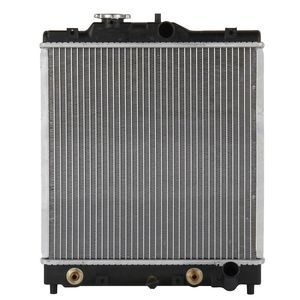A vehicle’s cooling system is vital for maintaining optimal engine temperature. The radiator, a key component of this system, dissipates heat to prevent overheating. When the radiator fails, it can lead to serious engine damage. This guide provides a comprehensive walkthrough for replacing a radiator yourself, saving you money on labor costs.
Gathering Your Tools and Materials for Radiator Replacement
Before you begin, ensure you have the necessary tools and materials. While seemingly straightforward, Radiator Replacement in modern cars can be complex due to integrated transmission coolers and other components. Here’s a checklist:
- Socket wrench set
- Car jack and jack stands
- Coolant
- Drain pan
- Absorbent material for spills
- Gloves and safety goggles
- Repair manual for your specific vehicle
- Distilled water
- Transmission fluid (if applicable)
Step-by-Step Radiator Replacement Procedure
Prioritizing Safety During Radiator Replacement
Safety is paramount. Disconnect the battery before starting to avoid electrical hazards. Raise the vehicle using a car jack and jack stands, ensuring it’s securely supported with wheel chocks and the parking brake engaged. Crucially, allow the engine to cool down completely before working on the radiator. Wear safety gloves and goggles to protect yourself from sharp edges and hot fluids.
Inspection and Preparation for Radiator Replacement
Before replacing the radiator, inspect the entire cooling system. Check the radiator cap, belts, and hoses for damage, cracks, or leaks. Examine the fan clutch for play in the bearings. Consider replacing the thermostat if the engine has overheated.
Draining the Old Radiator
Remove the radiator cap. Open the petcock valve or disconnect the lower radiator hose to drain the coolant into a drain pan.
Disconnecting the Radiator
Once drained, disconnect all hoses, clamps, and bolts securing the radiator. This typically includes the radiator reservoir hose, upper and lower radiator hoses, cooling fan connector, fan mounting bolts, fan shroud, transmission cooler lines (if applicable), engine oil cooler lines (if applicable), A/C condenser mounting bolts, and radiator mounting bolts. Organize these parts for reinstallation.
Removing and Installing the Radiator
Carefully lift the old radiator out of the vehicle. Install the new radiator in its place, ensuring it’s properly positioned.
Reconnecting and Refilling
Reattach all disconnected parts in reverse order of removal. Fill the new radiator with the correct coolant mixture, typically a 50/50 mix of coolant and distilled water. Consult your vehicle’s repair manual for the specific ratio.
Bleeding the Cooling System
Bleeding the system removes trapped air that can cause overheating. Consult your repair manual for the specific procedure for your vehicle. This often involves running the engine and monitoring the temperature gauge for overheating and leaks.
Common Mistakes to Avoid During Radiator Replacement
- Failing to bleed the cooling system: Trapped air can lead to overheating and poor heater performance.
- Over-tightening fasteners: This can damage the radiator.
- Using the wrong coolant: Consult your owner’s manual for the correct coolant type.
- Neglecting transmission fluid: If your radiator has an integrated transmission cooler, ensure the fluid level is correct.
Time and Cost Estimates for Radiator Replacement
Radiator replacement typically takes 3-5 hours for a DIYer. Parts and fluids can cost $150-$400 for the radiator itself, plus $50-$150 for additional components. Professional installation can add $200-$800 in labor costs.
Conclusion: Successful Radiator Replacement
By following these steps and taking necessary precautions, you can successfully replace your vehicle’s radiator. Remember to consult your vehicle’s repair manual for specific instructions and always prioritize safety. A properly functioning radiator is essential for a healthy engine, ensuring reliable performance and preventing costly repairs down the road.

